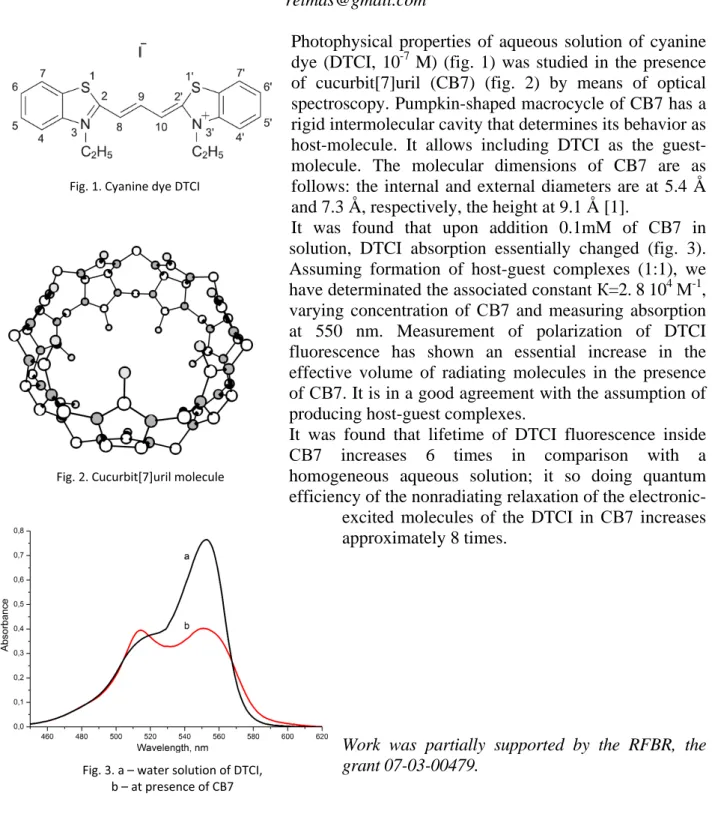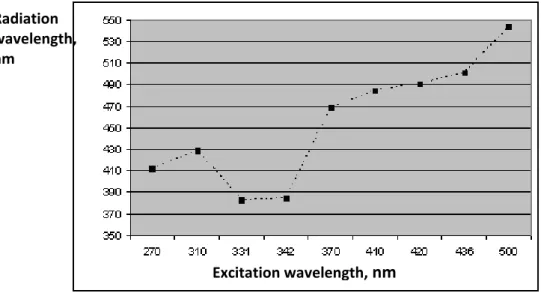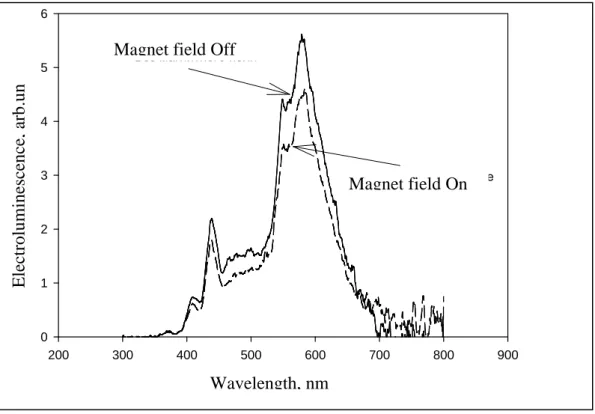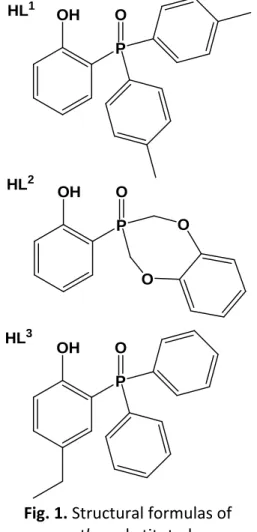48 SYNTHESIS, SELECTIVE AND PHOTOLUMINESCING PROPERTIES OF TERPYRIDINE DERIVATIVES - EFFECTIVE MOLECULAR RECEPTORS FOR ZINC(II) ION. 193 COMPARATIVE STUDY OF THE NON-LINEAR OPTICAL PROPERTIES OF MOLECULAR J AND H AGGREGATE IN THIN SOLID FILMS.
INTERNATIONAL CONFERENCE
ORGANIC NANOPHOTONICS”
ORALS
LINEAR AND NONLINEAR OPTICAL PROPERTIES OF UV-INDUCED GOLD NANOPARTICLES IN POLYMERIC MATRICES
FEMTOSECOND NANOPHOTONICS OF GOLD AND SILVER CLUSTERS PHOTODEPOSITED ON CRYSTALLINE
AND AMORPHOUS MESOPOROUS FILMS OF TiO 2
DISSOCIATIVE LUMINESCENT SENSOR BASED ON QUANTUM DOT / ORGANIC MOLECULE SYSTEM
SELF-AGGREGATION OF LUMINESCENT SILICA NANOPARTICLES IN AQUEOUS SOLUTIONS OF AMPHIPHILIC COMPOUNDS
AND SURFACTANTS
INCOHERENT ENERGY TRANSFER IN QUANTUM DOTS
TIME-DOMAIN LUMINESCENT SPECTROSCOPY
Despite recent progress in optical manipulation techniques of small objects such as laser tweezers and laser cooling, manipulation of nanoscale objects by radiation force is still challenging in nanotechnology. We also discuss our most recent theoretical results, such as those on manipulating nanoscale objects by projected light fields [3], size-selective manipulation of carbon nanotubes [4], and interparticle radiation-induced force which would be useful for manipulating the collective motion of nanoscale objects [5][6].
SILICON NANOPHOTONICS: PRESENT STATUS AND PERSPECTIVES L. Khriachtchev
NOVEL NANOCOMPOSITE MATERIALS BASED ON MESOMORPHIC GLASSES OF METAL ALKANOATES
ELECTROLUMINESCENCE OF ORGANIC MOLECULES IN BLUE-GREEN AND RED RANGES OF THE SPECTRUM
LEPR STUDY OF CHARGE TRANSFER PHOTOINDUCED IN POLYMER/FULLERENE BULK HETEROJUNCTIONS
OPTICAL AND ELECTROPHYSICAL PROPERTIES
AND APPLICATIONS OF ORGANIC AND ORGANIC-INORGANIC THIN FILM NANOSTRUCTURES
V. Kukhta
EFFECT OF J-AGGREGATES ON OPTOELECTRONIC PROPERTIES OF CONDUCTING POLYMERS
FABRICATION OF NANO SPACE
LASER AND ORGANIC NANOPARTICLES H. Masuhara
QUANTITATIVE ANALYSIS OF PH AND METAL IONS SENSITIVE PHOTOCHROMIC SPIROPYRANS AND SPIROOXAZINES
C. Micheau
CALIXARENE-BASED COMPLEXES AS PROMISING LUMINOPHORES FOR LUMINESCENT SILICA NANOPARTICLES
WITH ADSORBED METAL-ORGANIC CLUSTERS
SUPRAMOLECULAR WATER-SOLUBLE COMPLEXES OF CAROTENOIDS
BRANCHED AND DENDRITIC POLYARYLSILANES AS NANOSTRUCTURED LUMINOPHORES
THE EFFECT OF METALIC NANOPARTICLES ON THE OPTICAL CHARACTERISICS OF PORPHYNATES AND MEH-PPV SOLUTIONS
SPECTRAL AND LUMINESCENT PROPERTIES OF SEVEREL ACRIDINE COMPOUNDS IN SOLUTIONS AND SiO 2 -FILMS
OPTOELECTRONIC SENSOR SYSTEMS BASED ON THIN FILM ORGANIC ELECTRONICS
FULLERENE NANOCLUSTERS AS AMPLIFIERS IN LINEAR SPECTROSCOPY AND NON-LINEAR OPTICS
F. Sheka
FEMTOSECOND PRIMARY CHARGE SEPARATION IN PHOTOSYSTEM I
ELECTRONIC SENSORS ON THE BASIS OF NANOSTRUCTURED CERIUM OXIDE FILMS
UV-LIGHT STIMULATED FORMATION OF ORGANIC NANOPARTICLES
MATERIAL SOLUBILITY AND MISCIBILITY EFFECTS IN FULLERENE/POLYMER COMPOSITES USED AS
PEPTIDES AGGREGATES AS SUPRAMOLECULAR NANOSYSTEMS
STRUCTURE INVESTIGATIONS BY PULSED ELECTRON-ELECTRON DOUBLE RESONANCE (PELDOR) SPECTROSCOPY
NON-LINEAR OPTICAL AND PHOTONIC CRYSTALLINE CHROMOPHORE-CONTAINING POLYMERIC MATERIALS
Strong fluorescence quenching for (ZnOEP)2Ph or (ZnOEP)3Ph2 is governed by competing processes of energy migration (EM) and photoinduced electron transfer (PET) to the extraligand (~0.9 ps). In the case of covalently bound electron acceptors (A) of a non-porphyrin nature (quinone, pyromellithimide), the strong shortening of the decay of the S1 state (quenching of fluorescence) of the dimer is the result of EM and PET processes of the extraligand (~0.9-1.7 ps), which are faster than the slower PET «dimer→A» (34-135 ps) in toluene at 295 K.
POSTERS
POLYARYLENEPHTHALIDES – NEW POLYMER CLASS FOR ELECTROLUMINESCENCE DEVICES
MODELING OF NONLINEAR-OPTICAL ACTIVITY OF POLYMER ELECTRET AND RELAXATION STABILITY
OF ITS QUADRATIC RESPONSE M.Yu. Balakina
CONTINUUM MODEL FOR ELECTROSTATIC ENERGY OF INTERACTION OF A DIPOLAR ION OR DIPOLAR MOLECULAR
OPTICAL CONTROL OF NANOPOROUS POLYMERS SYNTHESIS PROCESS FROM PHOTOPOLYMERIZABLE COMPOSITES
SYNTHESIS, SELECTIVE AND PHOTOLUMINESCENT PROPERTIES OF THE DERIVATIVES OF TERPYRIDINES - EFFECTIVE
MOLECULAR RECEPTORS FOR ZINC(II) ION
New complexes of transition metals (Ni, Pd, Pt) and non-transition metals (Mg, Al) with fluorene-substituted porphyrins were prepd. Magnesium- and aluminum-fluorene-substituted porphyrins have been found to manifest more intensive fluorescence compared to free-base porphyrin and may be promising components of red light-emitting electrofluorescent devices.
WITH TRANSITION METAL CATIONS
MECHANOCHEMICAL PREPARATION
EFFECT OF THE CHROMOPHORES MUTUAL ORIENTATION ON NONLINEAR-OPTICAL RESPONSE OF MOLECULAR SYSTEM
INFLUENCE OF THE ORGANIC LIGHT-EMITTING DIODE STRUCTURE ON THE IR(PPY)3 ELECTROLUMINESCENCE
MODEL OF ENERGY CONVERSION EFFICIENCY FOR POLYMER PHOTOVOLTAIC CELLS
The photophysical properties of the aqueous solution of cyanine dye (DTCI, 10-7 M) (fig. 1) were studied in the presence of cucurb[7]uril (CB7) (fig. 2) by means of optical spectroscopy. Measurement of DTCI fluorescence polarization has shown a substantial increase in the effective volume of radiating molecules in the presence of СВ7.

TRIPLET-TRIPLET ENERGY TRANSFER IN NANODIMENSIONAL MOLECULAR LAYERS
SPECTROSCOPIC PROPERTIES OF LANGMUIR FILMS OF RHODAMINE DYES AND POLYAMPHOLYTIC POLYMER
NEW BLUE- AND GREEN-LIGHT-EMITTING
ELECTROLUMINESCENT POLYFLUORENES WITH 7,8,10- TRIARYLFLUORINE AERIAL FRAGMENTS IN BACKBONE
SPECTRAL AND SENSING PROPERTIES OF 9-DTAA DYE IN POLYMER MATRICES
POLYSUBSTITUTED DERIVATIVES OF PALLADIUM TETRAPHENYL TETRABENZOPORPHYRIN. SYNTHESIS AND PROPERTIES
STRUCTURE AND NONLINEAR OPTICAL PROPERTIES OF BILAYER CELLS WITH ORGANIC AND SEMICONDUCTOR NANOFILMS
INVESTIGATION OF DEGRADATION PROCESSES IN ORGANIC LIGHT-EMITTING DEVICES
DERIVATIVES OF DIVINYLBENZOXAZOLYLBIPHENYL
NEW ELECTROLUMINESCENT MATERIALS
MAGNETIC FIELD EFFECT ON THE POLYARYLENEPHTHALIDES ELECTROLUMINESCENCE
EXIPLEX ELECTROLUMINESCENCE SPECTRA IN THE ORGANIC LIGHT-EMITTING DIODES
INFLUENCE OF ETHANOL VAPORS ON SPECTRAL BEHAVIOR OF NILE RED IN ORGANIC-SILICATE MATRIX
EFFICIENT MULTILAYER ELECTROLUMINESCENT ORGANIC STRUCTURES BASED ON IRIDIUM(III) COMPLEX
DYNAMICS OF ABSORPTION AND LUMINESCENCE OF CdSe/ZnS QUANTUM DOTS IN THE PROCESS
OPTICAL FORMATION OF GRADED-INDEX WAVEGUIDE STRUCTURES IN PHOTOPOLYMERIZABLE COMPOSITES
NOVEL PHOTOCHROMIC SPIROPYRAN CATIONS WITH A PYRIDINIUM MOIETY IN THE ALIPHATIC SIDE CHAIN
THEORETICAL STUDY OF ADSORPTION OF AN ACRIDINE DYE AND SIMPLE MOLECULES ON A SILICA SURFACE
SPECTRAL BEHAVIOUR OF NILE RED IN ORGANIC-SILICATE SOL-GEL MATRI С ES
NEW ASYMMETRIC PHOTOCHROMIC BISPIROPYRAN OF THE 2,3-DIHYDRO-4-OXO-NAPHTO[2,1-E]OXAZINE SERIES OF THE 2,3-DIHYDRO-4-OXO-NAPHTO[2,1-E]OXO-NAPHTO SERIES [2,1-E]OXAZINE. The data of quantum-chemical calculations proved that some isomers are obtained as a result of the opening of both pyran rings in molecule 1. Changes in the intensity of absorption at 613 nm and 507 nm at different stages of the experiment for.
COPOLYMERS BASED ON CYCLOPENTADITHIOPHENE FOR ORGANIC PHOTOVOLTAICS
STUDY OF A POLYMER MATRIX INFLUENCE ON PHOTOCHROMISM OF SPIROPIRANES, INSERTED BY DIFFUSION FROM SOLUTIONS
It was found that when this film is placed in water containing Co or Ni ions, QD luminescence occurs with an intensity proportional to the ion concentration in the solution. The data show that the diffusion of Co or Ni ions from an aqueous solution into a polymer film containing QD/PAN complexes results in the dissociation of these complexes, followed by the appearance of QD luminescence. It was found that polymer films with embedded QD/PAN complexes can be considered as a luminescent nanosensor.
ATOMIC FORCE MICROSCOPY STUDY OF J-AGGREGATE NANOSTRUCTURES
NEW EUIII AND TBIII HEXAFLUOROACETYLACETONATES WITH BIDENTATE O-DONOR LIGANDS
SYNTHESIS, STRUCTURE AND OPTICAL PROPERTIES
SYNTHESIS AND OPTICAL PROPERTIES OF HIGHLY LUMINESCENT CdS QUANTUM DOTS
STARLIKE OLIGOTHIOPHENESILANES FOR PHOTOVOLTAIC APPLICATIONS
SYNTHESIS AND PHOTOLUMINESCENT PROPERTIES
A NEW TECHNIQUE TO FABRICATE DIFFRACTIVE OPTICAL ELEMENTS ON THE BASIS OF PERMOLECULAR STRUCTURES
POLYMER/NANOCARBONS COMPOSITE MATERIALS FOR PHOTONICS
DESIGNING FULLERENE/POLYMER BULK HETEROJUNCTION SOLAR CELLS WITH ADVANCED ACTIVE LAYER MORPHOLOGIES
When the film is placed in a water solution containing metal ions, they diffuse into the film and stimulate dissociation of the QD/PAN complexes. Since the luminescence is excited by optical radiation, the question arises of possible photodissociation of the sensor and its influence on parameters of the sensor's luminescence response. This information is important for determining the excitation light parameters necessary for sensor utilization for analytical applications.
SERS, SPECTROPHOTOMETRY AND AFM STUDY OF PHOTOCHROMISM OF SPIROCYCLIC COMPOUNDS
ON NANOSTRUCTURED METAL FILMS
In toluene solutions of PBC under the same conditions, only two photoproducts were observed - ВE with λmax = 600 nm and АКt with λmax = 500 nm. The nature of the solvent has a dominant influence on the number of photoproducts of PBC photolysis, the kinetics and mechanism of their bleaching reactions. The influence of substituents in the SA fragment of PBC molecules on the ratio of two photoprocesses and the lifetime of photoproducts is discussed.
ZINC)TETRAPHENYLPORPHYRIN-FULLERENE CHARGE-TRANSFER COMPLEXES
LITERATURE
The nonradiative relaxation of the dimer S1 state in self-assembled triads and pentads occurs within ∼1.6 ps with respect to τS=1.2 ns for individual dimer. Instead, fast EM and ET processes are followed by the effective population of the extra-ligand T1 state. Bimolecular rate constants for the extra-ligand T1 states that quench with O2 are reduced by 1.4-1.8 times those found for individual monomeric porphyrins.
SYMPOSIUM “MOLECULAR PHOTONICS”
INTERMOLECULAR INTERACTIONS AND PHOTOPROCESSES IN MOLECULAR SYSTEMS
AN EFFECT OF THE THIRD COMPONENT ON THE LUMINESCENCE OF THE NANO-SIZED
PROPERTIES AND APPLICATIONS V.A. Barachevsky
Another - "bottom-up" - approach requires the creation and research of the various molecular systems capable of acting as signal conductors, switches, diodes, memory elements and also logic devices. Dependence of values of output signals on inputs is defined by the truth table of the logical (Boolean) function. The response can be different, and thus it is possible to do different logical operations using the same molecular system.
EFFECT OF SOLVENT POLARITY ON THE PRIMARY PHOTOPROCESSES OF CYANINE DYES
K. Chibisov
Based on the results, a full description of the oxygen movement in the protein matrix will be given and the kinetic mechanism of protein self-regulation of ligand binding will be discussed. Therefore, to answer the question of which photocatalysts are more active, one needs to know the spectral distribution of the quantum yield for the corresponding photoreaction. A qualitative explanation will be given based on a model that takes into account the spectral variation of the electron transfer pathways.
TETRAPHENYLPORPHYRIN DERIVATIVES STRUCTURE AND MOLECULE SURROUNDINGS DEPENDING
ON LUMINESCENT CHARACTERISTICS
SPACE RADIATION IMPACT ON PREBIOTIC SYNTHESIS AND STABILITY OF BIOORGANIC MOLECULES: COMPARATIVE STUDY
INTENSITIES OF IR BANDS OF SURFACE OH GROUPS OR OF THE C-H STRETCHING BANDS OF ADSORBED MOLECULES – A NEW.
INTENSITIES OF IR BANDS OF SURFACE OH GROUPS OR OF THE C-H STRETCHING BANDS OF ADSORBED MOLEQULES – A NEW
THE EVOLUTION OF PHOTOCHEMICALLY GENERATED RADICAL PAIRS IN GLASSY POLYMERS: RECOMBINATION
FROM PHOTOSYNTHETIC BACTERIA
LUMINESCENCE TECHNIQUE IN THE STUDY OF BIOLOGICAL PROPERTIES OF FULLERENE BASED HYBRID NANOSTRUCTURES
RESULTS OF PHOTOCHEMICAL AND LUMINESCENCE STUDIES A.A. Krasnovsky
The quantum chemical investigation included modeling and DFT calculations according to the method B3LYP/6-31+G(d) of the geometry and electronic characteristics of adenine tautomers (Ade7 and Ade9) and adenine stacking dimers, consisting of Ade7 and Ade9, in aqueous solutions. Our quantum chemical calculations confirm the existence of energetically favorable stacking dimers of Ade in water (see Table 1). All stable stacking conformers in aqueous solutions of Ade7 and Ade9 have the interplanar distance R Å.

MODELING OF EVOLUTIONARY PRIMITIVE ENERGY CONVERTER AND MOLECULAR DEVICES BASED ON THE ACTIVITY
OF PHOTOEXCITED FLAVINS M.S. Kritsky
ENERGY TRANSFER IN THE MOLECULAR SYSTEMS NEAR DIELECTRIC AND METAL SURFACES
COOPERATIVE PROCESSES OF ANTI-STOCKES LUMINESCENCE EXCITATION IN CRYSTALS
THE ROLE OF INTRINSIC POINT DEFECTS IN SPECTRAL SELF- SENSITIZATION OF WIDE-BANDGAP OXIDE PHOTOCATALYSTS
Lisachenko
TRIPLET ENERGY TRANSFER FROM d 0 ORGANOMETALLICS TO UNSATURATED HYDROCARBONS
SENSIBILIZED ANTI-STOCKES LUMINESCENCE MECHANISM IN CRYSTALLS WITH ADSORBED METALORGANIC
NANOSTRUCTURES
LUMINESCENCE STUDY OF STABLE STACKING AGGREGATES OF NITRIC BASES OF NUCLEIC ACIDS – THE CANDIDATES
Spectra of HCN/D2O and ND3/D2O ice mixed films with low (1:10) dopant/water ratios do not show any change in the acidic or basic properties of the pendant hydroxyl groups or surface oxygen atoms, but reveal a difference in the ratio between the concentrations of these sites compared to pure water ice. Co-adsorption of ozone with HCN in the dark does not lead to any noticeable spectral changes. However, the UV radiation of this system results in the appearance of new bands that reveal the formation of ozonolysis products.
THE PRODUCTS AND MECHANISMS OF PHOTOCHEMICAL TRANSFORMATION OF O-QUINONES
MESO-SUBSTITUTED POLYMETHINE DYES AS EFFICIENT SPECTRAL-FLUORESCENT PROBES FOR BIOMACROMOLECULES
Mineral templates can drive light-dependent processes that result in the formation of molecules of varying complexity. The energizing particles of the clay mineral, montmorillonite, were shown to catalyze the formation of pyrophosphate and phosphoanhydride bonds in the nucleotide coenzymes ATP and FAD. Thermolysis of amino acid mixtures results in the formation of abiogenic pigmented polymers (flavoproteinoids) which aggregate and form microspheres.
ADVANCES IN SPECTRAL STUDIES OF SURFACE PHENOMENA A.A. Tsyganenko
BACTERIORHODOPSIN-CONTAINING MULTILAYER STRUCTURES AS A MEDIUM FOR BIOMOLECULAR NEURONET DEVICES
OF PHOTONICS
PROTONATION EFFECT AND SPECTRAL PROPERTIES OF PHOTOCHROMIC COMPOUNDS
SPECTRAL-FLUORESCENT INVESTIGATION OF THE INTERACTION OF THE POLYMETHYNE DYE CY2 WITH DNA AND HYALURONIC ACID.
SPECTRAL-FLUORESCENT STUDY OF THE INTERACTION OF THE POLYMETHINE DYE CY2 WITH DNA AND HYALURONIC ACID
RELAXATION OF HIGH-LYING EXITED ELECTRONIC STATES OF POLYPYRIDYL RU(II) COMPLEXES AND ITS RELATION TO
2D-STRUCTURE EVIDENCE ON THE SURFACE OF SELF-SENSITIZED ZnO PHOTOCATALYST
A “sandwich” structure is developed with a parallel (D13-1) and an antiparallel (D13-2) orientation of the short axes of the molecules that form a dimer. The calculations of rate constants of photophysical processes in dimers show that the formation of dimers significantly affects the energy level diagram of the excited electronic states of the monomer. In addition, the value of the rate constant of these non-radiative processes depends on the dimer structure.
THE STRUCTURE AND PHOTOPHYSICAL PROCESSES IN SYMMETRIC POLYMETHINE DYES
SHORT AND LONG-RANGE ORDER EFFECT ON RESONANCE ENERGY TRANSFER
N. Bodunov
THE LIQUID CRYSTAL COMPOSITES CONTAINING AN IMPURITY OF FLUORESCENT CdSe NANORODS
INVESTIGATION OF SPECTRAL PROPERTIES OF ISOXAZOLE DERIVATIVES CONTAINED PHOTOCHROMIC LABEL
HETEROGENEOUS PHOTOCATALYSIS BY ZIN С PHTHALOCYANINE DERIVATIVES FOR PHENOLS OXIDATION
SPECTRAL-LUMINESCENT AND LASING PROPERTIES OF THE SOME SUBSTITUTED OF COUMARIN
NEW RADICAL MECHANISM OF PORPHYRIN PHOTOSENSITIZED DESTRUCTION OF BIOLOGICAL MEMBRANES
The purpose of the presented work is to try to prevent destruction during recording and partial deletion during reading of information. To avoid the erasure of the recorded information, it is usually possible by means of matrices where the photochromic transformation is accompanied by changes which can be detected without destroying the written information. Therefore, reading through the Bragg reflection band, rather than an absorption maximum, will ensure the storage of written information without loss.
INVESTIGATION OF THE PHOTOCHROMIC BEHAVIOUR OF THE RETINAL PROTEIN CHROMOPHORE MODELS
INTERACTION OF CYCLOTETRAPYRROL COMPOUNDS WITH NANOPOROUS XEROGELS AND OPTICAL RADIATION
OF DIFFERENT INTENSITY
THE INVESTIGATION OF THE NO PHOTOADSORPTION IN CO- PRESENCE ON TiO2 HOMBIFIIN N BY MEANS OF.
DIFFUSE REFLECTANCE SPECTROSCOPY FOR INVESTIGATION OF GAS-SURFACE INTERACTIONS ON WIDE-BANDGAP OXIDES
Photoinduced oxygen isotopic equilibration (POIE) 16O2 + 18O2 → 216O18O on TiO2-x was used to test the stability of surface defects in the reduced sample upon irradiation in an oxygen atmosphere and to test the photocatalytic activity in the absence of the reducing agent CO. was investigated. After the light is turned off, the reaction continues ("memory" effect) and R slowly drops to zero. During POIE, there were no changes in the total pressure, which indicates the invariance of the adsorption-desorption balance.
EFFECTS OF DONOR STRUCTURE ON TRIPLET ENERGY-TRANSFER FROM AMINES TO ALKENE IN SOLUTION
One of the most interesting manifestations of this interaction is associated with non-radiative photoprocesses - the energy transfer of electronic excitation between two chromophores. This theory allows you to determine the dependence of the energy transfer efficiency on the spectral-luminescence properties of the molecules of a donor and an acceptor. Overall, the results of the quantum-chemical approach to the research of the energy transfer process.
PROBE PHOSPHORESCENCE AND TRIPLET-TRIPLET ENERGY TRANSFER IN THE STUDY
OF CONFORMATIONAL CHANGES IN THE PROTEINS
COMBINED KINETIC, UV-VIS, FTIR AND TPD STUDY OF THE PHOTOCATALYTIC NO REDUCTION BY CO ON TiO 2
MATHEMATICAL SIMULATION OF STRATEGY FOR THE CONTROL OF EXCITED- STATE INTRAMOLECULAR REVERSIBLE PROTON
A. Morozov
PREPARATION OF MAGNESIUM PHTHALOCYANINE NANOCRYSTALS
One of the most promising macromolecular compounds that contain photo-operated groups and are therefore able to convert light energy into chemical bond energy can be chalcone podanders. It has also been shown that the selectivity of photocycloaddition can be regulated by changing the template concentration and varying the light irradiation range. One of the main requirements for the molecules of efficient polymeric photostabilizers is highlighted to be the absence of two-photon processes, which are possible by efficient radiationless conversion, initiated by reversible adiabatic chemical reactions.
FTIR STUDY OF METHANE INTERACTION WITH OXIDE ADSORBENTS
LUMINESCENT INVESTIGATION OF ACRIDINE HOMO-CONJUGATED COMPLEX
PROTONATED NITROGEN-CONTAINING AROMATIC MOLECULES
SPECTROSCOPIC INVESTIGATION
ETHYLENE PHOTOPOLYMERIZATION ON ZEOLITE NA–ETS-10
IR SPECTROSCOPIC STUDY
In this work, the photoozonolysis of chlorinated ethenes and hydrogen cyanide on/in ice films was investigated by FTIR spectroscopy at 77 – 200 K. To investigate the influence of water addition on the reaction mechanism, photoozonolysis of hydrogen cyanide in mixed HCN /H2O ice at 77 K has been investigated. It was found that adding water promotes faster HNCO formation during the photoozonolysis process.
THE EFFICIENCY OF UV STIMULATED FORMATION OF ACTIVE CENTERS AT THE SURFACE OF MICRO-
AND NANO-DISPERSED ZrO 2 PHOTOCATALYSTS
DECAY TIME OF ACTIVE SURFACE CENTERS ON WIDE BAND GAP METAL OXIDES
STRUCTURE AND PHYSICO-CHEMICAL PROPERTIES OF PHOTOACTIVE SUPRAMOLECULAR SYSTEMS BASED
BY ENERGY TRANSFER TO DYES T.A. Shakhverdov
COMPARATIVE STUDY OF SPECTRAL PROPERTIES OF CROSS- CONJUGATED BISAMINOKETONES AND DINITRILES
DECAY KINETICS OF TRIPLET STATES AND RADICALS OF FLAVINS IN THE BOVINE LENS STUDIED BY LASER FLASH PHOTOLYSIS
FLUORESCENCE RESONANCE ENERGY TRANSFER
REACTIONS OF PHOTOINDUCED AND THERMAL RECOORDINATION IN OPTICAL MOLECULAR SENSORS
INFLUENCE OF THE SOLVENT ON THE RADIUS OF ELECTRON-EXCHANGE INTERACTIONS
In contrast to MgO3, CO adsorption on CaO pre-exposed to CO2 or SO2 is not accompanied by OH band perturbations, and adsorption of DMP does not lead to characteristic bands of protonated base molecules. For CaO degassed at 773 K or exposed to H2O at 300 K, the surface concentration of OH groups is much higher, but after adsorption of CO2 or SO2, the intensity of the high-frequency CO bands is lower than for the sample treated at 973 K. Thus assigning we the high-frequency CO band to molecules coordinately bound to surface cations whose electron-accepting ability is enhanced as a result of CO2 or SO2 adsorption.
SYMPOSIUM
FUNDAMENTAL PRINCIPLES OF NANOPHOTONICS”
OBTAINING, PROPERTIES AND PERSPECTIVES OF COLLOIDAL QUANTUM DOTS
SEMICONDUCTOR QUANTUM DOT MOLECULE PHOTOLUMINESCENCE MEDIATED BY
MOLECULAR DESIGN OF LIGHT-SENSITIVE NANOSIZED SYSTEMS BASED ON UNSATURATED AND MACROCYCLIC COMPOUNDS
AOT/WATER/HEXANE REVERSE MICELLES AS “MICELLAR SIEVES”
DELAYED FLUORESCENCE ANNIHILATION KINETICS CHANGE BY RECONSTRUCTION OF POLYMERIC CHAIN STRUCTURE IN
THE FEATURES OF THE RECOMBINATION PROCESSES INTO THE PYROLYTIC CdS FILMS
LUMINOPHORE-CONTAINING MONODISPERSE
POLYMERIC NANOPARTICLES: DESIGN, SELF-ASSEMBLING, AND APPLICATION FOR CHEMISENSORICS
MOLECULAR DYNAMICS SIMULATIONS OF AN AOT REVERSE MICELLES SELF-ASSEMBLY
V. Nevidimov
SUPRAMOLECULAR ENSEMBES OF Ru(II) PHTHALOCYANINATE, NONLINEAR OPTICAL AND PHOTOREFRACTIVE PROPERTIES
Moreover, ellipsometric measurements show that the PhC films have birefringence in the substrate plane. The index axis Ng is directed along the crystal growth line, Nm lies in the plane of the film surface and is orthogonal to Ng. This phenomenon requires an adequate theoretical description and takes into account in the engineering of elements for photonics.
LASING IN PHOTONIC CRYSTAL OPAL FILMS AND HETEROSTRUCTURES
POLARIZATION AND ORIENTATION ANISOTROPY OF RESONANT OPTICAL PROPERTIES IN POLYMER 3D PHOTONIC CRYSTALS
A particular contribution of these spectral components to the blue emission of a given solution depends on the chemical structure of the fullerene. The quantum-chemical calculations carried out in the study allowed to estimate the strength of intermolecular interaction in groups and to underline their origin of charge transfer. The observed enhancement of linear optical events is considered within the framework of the local broadening field model and is related to the resonance excitation of clusters which are spatially extended charge transfer complexes.
NANOPHOTONICS IN PRINTING AND PACKAGING
Electronic spectra of NPs are size-dependent due to quantum confinement effects, and the term quantum dot (QD) is widely used to designate them along the lines of other low-dimensional systems. The overlap of NP excitation profiles enables NPs with different emission wavelengths to be excited simultaneously. It was determined that the size of the NPs as well as the stoichiometric PE:NPs molar ratio are the crucial parameters, which determine the topology of the NPsPE complexes lying on a solid substrate.
SEMICONDUCTOR PHOTOCATALYSIS ON THE NANOSCALE
STATE-OF-THE-ART AND PERSPECTIVES
COFLUORESCENCE OF DYES IN NANOSTRUCTURES OF METAL ION COMPLEXES WITH DIKETONES
Nanosized structures (nanoclusters, NCs and nanoparticles, NPs) of organic and inorganic materials are of interest for photophysics research and applications in organic solar cells. PCBM molecules (both electron acceptors and quenchers of polymer luminescence) form NCs during the polymer composition preparation process. Photophysical properties of metal NCs and NPs are of particular interest for use in organic solar cells [10].
SPATIAL DISPERSION AND LOCAL FIELD EFFECTS FOR SEMI-INFINITE MEDIA WITH EMBEDDED NANOPARTICLES
ORDERED STRUCTURES ON THE BASIS OF SELF-ASSEMBLY OF CdSe AND Au PARTICLES
OPTICAL PROPERTIES OF NANO-STRUCTURED POLYMER LIQUID CRYSTAL COMPOSITES
DIFFERENTIAL PARAMETERS OF ORGANIC PHOTOELEMENT WITH BULK HETEROJUNCTION
A COMPARISON OF THE PHOTOPHYSICAL PROPERTIES OF CADMIUM CHALCOGENIDE NANOPARTICLES
SYNTHESIZED BY VARIOUS METHODS
INVESTIGATION ON THE POSSIBILITY OF COVERING CYANINE DYE J-AGGREGATES WITH SILICA SHELLS
V. Ivanchikhina
THE LUMINESCENCE OF POLYMER COMPOSITE MATERIALS WITH CdS NANOPARTICLES
SINGLE-WALLED CARBON NANOTUBES
ZIRCONIA NANOPARTICLES AS NEW MODEL MATERIAL FOR NANOPHOTONICS: EFFECTS OF SELF-ORGANIZATION
LIGHT EMISSION AND OPTICAL PROPERTIES OF SILICON RICH SILICON OXIDE SILICON NITRIDE.
LIGHT EMITTING AND OPTICAL PROPERTIES OF SILICON-RICH SILICON NITRIDE AND SILICON-RICH SILICON OXIDE FILMS
THE ABSORPTION AND LUMINESCENT ANALYSIS
SILICA NANOPARTICLES MODIFIED BY PYRYLOCYANINE DYE WITH EFFECTIVE LUMINESCENT RESPONSE
COMPARISON STUDY OF THE NONLINEAR OPTICAL PROPERTIES OF MOLECULAR J- AND H- AGGREGATES IN THIN SOLID FILMS
LARGE ANGULAR DISPERSION EXPERIENCED
We observed this gap in the spatial distribution of optical radiation from the fluorescent 1D photonic crystal formed by hologram written in the CaF2:Na crystal. The spatial frequency of the hologram was equal to 1/2 of the reciprocal wavelength of the luminescence band maximum corrected for the crystal refractive index. The optical scheme made it possible to detect the spatial distribution of the luminescence at CCD camera plane, which was parallel to the hologram plane.

STRUCTURAL ASPECT OF NANOPHOTONICS OF FULLERENE SOLUTIONS
MONODISPERSE POLYMERIC NANOPARTICLES MODIFIED WITH CYCLODEXTRINS AND DYES
RELATIONSHIP BETWEEN WATER VAPOR PRESSURE OF REVERSE MICELLAR SYSTEM AND REVERSE MICELLES SIZE DISTRIBUTION
THE STUDY OF ENDOTAXIAL NANOSTRUCTURIZATION OF POLY(3-HEXYLTHIOPHENE)/FULLERENE COMPOSITE

![Fig. 3. a – water solution of DTCI, b – at presence of CB7 Fig. 2. Cucurbit[7]uril molecule](https://thumb-eu.123doks.com/thumbv2/pdfplayernet/426721.46314/56.892.128.396.292.733/fig-water-solution-dtci-presence-cb7-cucurbit-molecule.webp)



